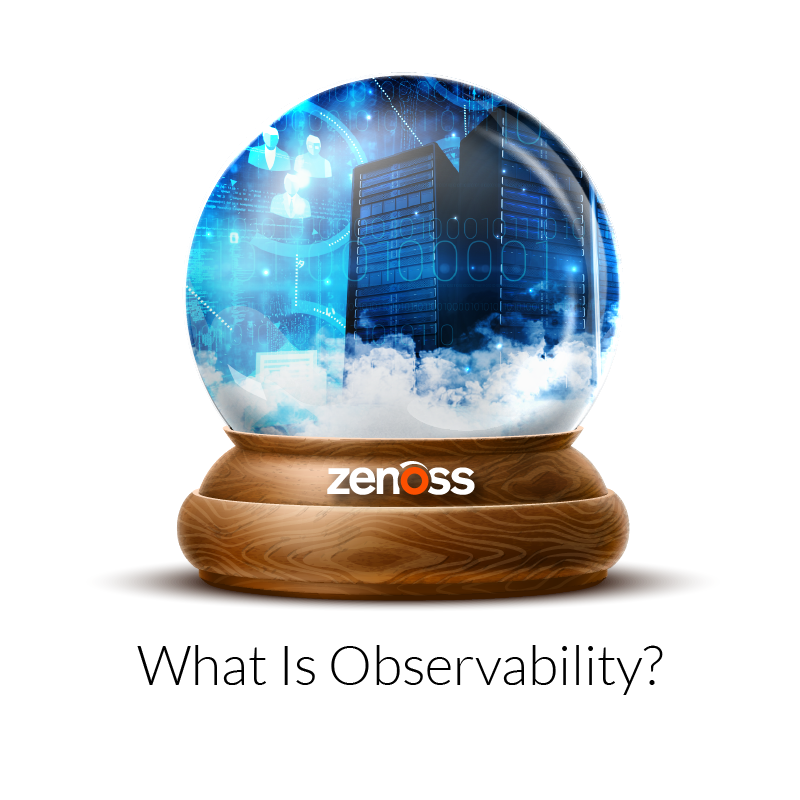
Often, the term is used interchangeably (and incorrectly) with “visibility” to describe viewing one's data. However, observability goes a step beyond, allowing you to gain insights from various logs, metrics and traces. While many software vendors are using the term, there are different viewpoints on the actual definition.
So, what exactly is observability? How does it work, and why does it matter?
What Exactly Is Observability?
Observability is a term derived from control theory that software vendors have borrowed for IT Ops. In control theory, observability refers to the extent to which you can infer the internal states of a system based on knowledge of its external outputs and performance.
What does this mean in the context of IT Ops and DevOps?
According to Gartner1, "Observability is the evolution of monitoring into a process that offers insight into digital business applications, speeds innovation and enhances customer experience. I&O leaders should use observability to extend current monitoring capabilities, processes and culture to deliver these benefits."
In other words, observability leverages continuously collected performance and telemetry data from across your infrastructure, correlating it in real time to offer insights into your IT environments.
What’s the Difference Between Observability and Monitoring Tools?
Similar to the term "visibility," vendors often think of observability and monitoring as one and the same. However, while these concepts are related and even complementary, they are distinct ideas.
Monitoring tools passively collect large volumes of data that, while mostly significant, can quickly overwhelm your operations team. As modern IT environments increase in complexity and the number of interdependent variables, observability tools focus on actively aggregating relevant data on factors that impact operations and drive better decisions.
This aspect is critical.
Whereas monitoring is the collection and analysis of metrics around more predictable application, system or network performance issues, observability enables human beings to query data to get more context in order to find the root-cause issues in less predictable systems, primarily those that are cloud native.
These solutions, together, provide a comprehensive view of your architecture with the necessary context to deliver actionable insight into your infrastructure components.
How Do Observability Platforms Work?
The average monitoring tool typically relies on your team to build or customize a dashboard that displays critical performance indicators based on potential problems they foresee. However, today's complicated IT environments and cloud-based applications face a wide range of unpredictable challenges and security threats. An observability platform leverages collected telemetry data throughout your infrastructure, enabling your engineers to debug potential network, application or system performance issues in scenarios that were previously unknown.
The 3 Pillars of Observability
To gather the data they need, observability systems integrate with existing sensors and other instruments built into your applications and infrastructures. This allows them to capture the three primary types of telemetry information:
1. Logs
A log is a time-stamped, textual record of discrete events over a certain period. Event logs can help you create a highly granular step-by-step account of what happened with additional context. These records come in three different formats:
- Plain text.
- Structured.
- Binary.
2. Metrics
Metrics are numerical measures of data on the behavior, health and performance of your infrastructure components. These values can help you track things like:
- CPU capacity.
- Memory utilization.
- Latency during usage spikes.
- Much more.
3. Traces
A trace shows the end-to-end journey of a request or action through a distributed system. This trace enables you to observe these requests or actions as they move through hybrid cloud environments by tagging them with a unique identifier. This allows you to follow interactions across your systems — from containerized applications to microservices.
Why Do We Need Data Observability?
The answer is simple: Modern cloud architectures have become so complex and dynamic that, without observability, it's extremely difficult to identify (let alone prevent) the cause of digital service issues.
Just as external data is not solely sufficient, neither is internal data from system components. For modern digital services, observability requires a combination of internal and external data. That means visibility into the gamut of event logs, component metrics and traces.
The sheer amount of data being collected requires a modern AIOps solution to derive the critical insights that accelerate the problem resolution and improve the end-user experience. What does this mean for your business? You get reduced risk, faster deployment time for new technologies, and, in the end, better experiences for your customers.
Common Challenges With Observability
In modern cloud environments, organizations continuously generate a massive volume and variety of telemetry data, especially when they’re using microservices and containerized applications. As a result, it's increasingly difficult to keep up with the flow of information — and that's not to mention the time it takes to interpret, troubleshoot and resolve a performance issue.
To combat these problems, organizations have made observability a top priority. Unfortunately, they often run into a few challenges, such as:
1. Siloed Data
Disparate data sources make it difficult to monitor and understand interdependencies across applications, systems, networks and cloud environments. Without the right integrated observability tools, you might be missing information from a critical data source.
2. Volume, Velocity and Variety
Your teams likely pull together insights from a suite of monitoring tools and dashboards. However, the increasing amount of data, the speed at which it comes out, and the wide variety of data types make it nearly impossible to get the answers you need when you need them. In the end, your record of events becomes a patchwork of information and guesswork gathered from multiple reports and time stamps.
3. Manual Tools and Practices
As organizations implement new technologies, it can create an overwhelming tsunami of data that requires increasingly complex monitoring configurations. This ultimately creates blind spots that leave you vulnerable in today's ever-changing landscape. When your team uses IT resources on manual monitoring tools, you wind up spending more time setting up an observability system than you do gaining actionable insights from your data.
4. Monitoring Containers and Microservices
Containerized applications and microservices provide your operations team with the agility it needs to succeed, but their dynamic nature creates issues in real-time visibility. Without the necessary observability tools, your team can't perform tracing or find the root cause of anomalies across microservices. This creates the additional step of having to consult with the system's original engineer, slowing down your operations.
The Benefits of Full-Stack Observability
While many organizations face the common challenges outlined above, the right observability solution can help you get around these issues, bringing significant benefits to your organization. From providing a comprehensive view of your architecture to reducing operational costs and improving the user experience, observability platforms can give your organization a competitive advantage by:
1. Improving Business Analysis
With a full-stack observability solution, companies can use analytics and performance metrics in combination with business context to interpret the real-time impacts. This comprehensive view and added contextual data provide your team with everything they need to make smarter business decisions.
2. Simplifying Complex Architecture
Distributed systems and siloed data sources make it difficult for developers to monitor and understand things like application performance and services. Data observability offers a clear and complete view of your complex IT architecture by providing you with critical context.
3. Boosting Productivity and Efficiency
With a well-configured observability system, your developers can trace a request or action across its entire journey. Added contextual data provides a comprehensive view of the situation, streamlining the investigation, root-cause analysis and response. That way, your team won't need to spend as much time on error investigation, allowing them to debug and optimize the application for a faster resolution.
4. Preventing Unexpected Downtime
The relevant data you receive from an observability platform empowers your IT team to quickly and accurately identify unforeseen issues. This efficiency improves troubleshooting time and reduces MTTR, allowing you to stay ahead in today's fast-paced digital world.
5. Driving Faster Development
Monitoring and troubleshooting are two of the primary friction points for many developers. By removing (or at least mitigating) these obstacles with a data observability tool, your DevOps team can increase the speed of delivery and deployment, reducing each product's time to market. Plus, these time savings can even translate to more time for innovation that drives your business forward.
Key Features of Any Observability Solution
Machine learning has come a long way in recent years. But with the vast amounts of data being collected, simply relying on algorithms to identify anomalies isn’t enough. With typical enterprises collecting billions of events each day, Gen 1 AIOps tools are often finding thousands of “anomalies” per day, which, obviously, isn’t that helpful. The algorithms need more context to deliver true insights.
Deploying the right AIOps technology with a service-centric monitoring platform can provide this context, enabling inference capabilities such as true anomaly detection, root-cause analysis and intelligent dashboards.
But how can you identify the best observability tool for you? Whether you go with an open-source technology or commercial software, here's a checklist of the key features that every effective solution should have:
- A user-friendly software interface that’s easy to learn, use and understand.
- Real-time insights through live dashboards and customizable reports.
- Seamless integration with your existing digital ecosystem, including support for the languages you're using.
- Visualizations like graphs and charts, which are essential in understanding your aggregated data.
- Filters that sift through data to reduce unimportant information and minimize alert fatigue.
- Full contextual data needed to perform root-cause analysis.
- Business value-adds such as faster deployment, improved stability and a better user experience.
Manage Your Architecture With Modern Monitoring + AIOps
Modern observability platforms have responded to the challenges organizations face. These solutions have evolved to collect all types of data from all systems, ascertaining digital service structures and dependencies, and then feeding that rich data to machine learning algorithms to uncover insights previously unable to be derived. This is true observability.
Check out this white paper to learn more about modern monitoring and AIOps with Zenoss Cloud.
1Innovation Insight for Observability, Gartner, 28 September 2020. https://www.gartner.com/en/documents/3991053.







